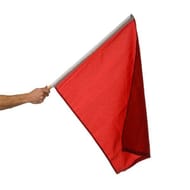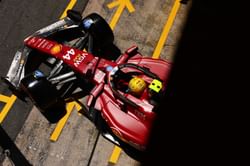Formula 1 Flags Meaning Explained
The race officials directly communicate with the drivers using flags to indicate track conditions and relay critical communications.
Racing Flags indicate caution and danger, and more often than not, the show of flags during races have drastically changed the outcome of the Grand Prix.
Let us look closer and understand what these flags mean. All the flags have a unique meaning and denote different things in the race.
F1 Racing Yellow Flag Meaning

The yellow flag is shown in case of any danger, which could be due to a collision, or due to a mechanical or an electrical failure.
The way a yellow flag is waved also plays a crucial role and has different meanings. The driver must slow down at the sight of a yellow flag, and double waved yellow flags indicate that the driver must be prepared to stop until the situation is resolved.
It is accompanied with a safety car sign if the safety car is on track.
Overtaking is prohibited in all the cases.
F1 Racing Red Flag Meaning

The red flag is shown to halt a session. Bad weather conditions, poor track conditions, or an accident on the track warrants the use of a red flag.
The most recent red flag during a race session was seen in the 2017 Azerbaijan Grand Prix on lap 22. Debris on the track due to multiple accidents warranted the cause of the flag. It was later restarted, and Daniel Ricciardo of Red Bull picked up the win.
F1 Racing Blue Flag Meaning

A blue flag is shown to a car that is about to be lapped by a faster car. The slower car must allow the faster car to pass before the show of three blue flags or risk being awarded a penalty.
Moreover, the blue flag is also shown at the exit of the pit lane to warn the driver of a faster car present on the racing line.
F1 Racing Green Flag Meaning

Green flags are waved to indicate drivers to resume racing. It is shown when the driver has passed a potential danger or after the track has been cleared of debris. Drivers are free to overtake and resume race pace.
F1 Racing Black Flag Meaning

The black flag is accompanied by the car number and indicates that the driver is disqualified from the race. The driver is directed to return to the pit and will take no further part in the race.
Filipe Massa and Giancarlo Fisichella are the last drivers to be black flagged. They were shown a black flag in the 2007 Canadian Grand Prix for exiting the pit lane when the red light was still on.
F1 Racing White Flag Meaning

White flags indicate a slow-moving vehicle. It is often waved at the end of the last corner and the pit straight at the end of free practice sessions when drivers are performing practice starts.
F1 Racing Checkered Flag Meaning

A checkered flag or the chequered flag is waved at the end of a session. The race leader is shown the checkered flag at the end the race.
The checkered flag is also waved at the end of the allotted time during practice and qualifying sessions which indicates the end of the session.
F1 Racing Black with Orange Circle Flag Meaning

This flag indicates that the driver has a mechanical issue and must return to the pits. Like the black flag, this one too is accompanied with a car number.
F1 Racing Half Black / Half White Flag Meaning

The black with orange flag is shown to warn the driver of unsportsmanlike conduct. Not mending their ways on the track could ultimately lead to a black flag.
F1 Racing Yellow and Red Striped Flag Meaning

The Yellow and Red flag indicates a deterioration of the track grip due to water, oil and other lubricants.
These were all the flags that are used in Formula 1 for different times and cases during the Grand Prix.









